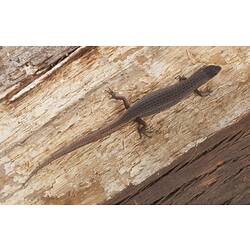General Description
Golden brown back with pale flecks, sometimes a black streak at top of flanks and distinctive russet stripes from above the hind limbs converge at the tail tip. Under side white to bright lemon yellow. Snout to base of tail length up to 7 cm. The tail can be up to twice as long as the body.
Biology
Weasel skinks live on the ground. They are active but usually only seen amongst leaf litter or ground debris diurnally (ie. during the day) or at dusk on warm nights. These skinks raise their body temperature by contact with the surroundings, rather than by basking in the sun. They are common in suburban gardens. This species lays eggs (ie. it is oviparous) rather than giving birth to live young. It is one of a number of small skinks where the females have communal nesting sites often under timber piles in backyards. These nests can have 50 or more eggs. If you find a nest, please replace the timber carefully and wait until the eggs have hatched in autumn.
Distribution
Coast and ranges of New South Wales, and eastern and southern Victoria.
Habitat
Leaf litter in habitats ranging from coastal heathland to the wet and dry schlerophyll forests of the Great Dividing Range.
More Information
-
Animal Type
-
Animal SubType
-
Brief Id
A small golden brown skink with pale flecks and distinctive red brown stripes running from above the hind limbs to the tip of the tail.
-
Colours
Brown, Orange
-
Maximum Size
4.5 cm
-
Habitats
-
Diet
Insects
-
Diet Categories
Invertebrates, Insects
-
Endemicity
-
Commercial
No
-
Conservation Statuses
CITES: Not listed, FFG Threatened List: Not listed, EPBC Act 1999: Not listed, IUCN Red List: Least Concern
-
Taxon Name
-
Scientific Author
(O'Shaughnessy, 1874)
-
Common Name
Weasel Skink
-
Kingdom
-
Phylum
-
Subphylum
-
Class
-
Subclass
-
Order
-
Suborder
-
Infraorder
-
Family
-
Genus
-
Species Name
mustelinus



